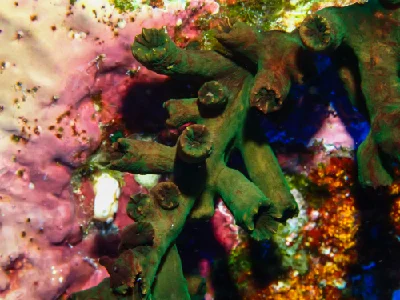Black Sun Coral
Tubastraea micranthus
Overview: Black Sun Coral, scientifically known as Tubastraea micranthus, is an incredibly unique and striking species of coral that finds its natural habitat in the vibrant and biodiverse waters of the 🌊 Red Sea. Despite being part of the commonly known 'sun corals,' Tubastraea micranthus stands out due to its unusually dark coloration and fascinating biological characteristics.
Physical Description: This coral species exhibits an attractive, dark green to black hue that contrasts dramatically with the more common bright and colorful corals. Its polyps are quite robust and often extend fully, creating a dense, bushy appearance. The polyps' extended state gives the coral a somewhat fluffy, yet intricate structure. Each polyp has a series of tentacles resembling miniaturized suns – a namesake feature shared with its brightly colored relatives, although in this species they do not have the typical yellows and oranges.
Habitat: Tubastraea micranthus predominantly resides in shaded or low-light environments, such as overhangs, caves, and deep crevices within the coral reef ecosystems of the 🌊 Red Sea. It is quite adaptable to various depths but thrives best where it can avoid direct, intense sunlight. This preference for dimmer locations is partly due to its lack of symbiotic algae (zooxanthellae), which many other corals rely on for photosynthesis.
Feeding: Unlike many coral species that depend on photosynthetic algae, Black Sun Coral is azooxanthellate, meaning it doesn’t form a symbiotic relationship with algae. Instead, it is a heterotrophic feeder and captures plankton and other small particles from the water column using its extended polyps. This feeding strategy allows it to inhabit areas that might be less hospitable to other corals that rely on sunlight.
Reproduction: Reproduction in Tubastraea micranthus occurs both sexually and asexually. Sexual reproduction involves the release of gametes into the water column, a process timed to increase the chances of fertilization. Asexual reproduction occurs through budding, where new polyps form directly from the parent coral, contributing to the formation of large, contiguous colonies.
Ecological Importance: In the intricate tapestry of the 🌊 Red Sea ecosystem, Tubastraea micranthus plays a significant role. Its unique structure offers habitat and shelter to various marine creatures, including small fish and invertebrates. However, its competitive nature can sometimes overshadow other coral species, especially in areas where it establishes densely packed colonies.
In summary, the Black Sun Coral (Tubastraea micranthus) is a visually stunning and ecologically vital species within the 🌊 Red Sea. Its unique adaptive strategies, dark pigmentation, and feeding habits make it a fascinating subject of study and an integral component of its natural habitat.
Comments
Please, sign in to leave comment
No Comments yet
Last Update: May 28, 2025

